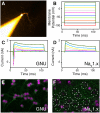Vertical silicon nanowires as a universal platform for delivering biomolecules into living cells
- PMID: 20080678
- PMCID: PMC2836617
- DOI: 10.1073/pnas.0909350107
Vertical silicon nanowires as a universal platform for delivering biomolecules into living cells
Abstract
A generalized platform for introducing a diverse range of biomolecules into living cells in high-throughput could transform how complex cellular processes are probed and analyzed. Here, we demonstrate spatially localized, efficient, and universal delivery of biomolecules into immortalized and primary mammalian cells using surface-modified vertical silicon nanowires. The method relies on the ability of the silicon nanowires to penetrate a cell's membrane and subsequently release surface-bound molecules directly into the cell's cytosol, thus allowing highly efficient delivery of biomolecules without chemical modification or viral packaging. This modality enables one to assess the phenotypic consequences of introducing a broad range of biological effectors (DNAs, RNAs, peptides, proteins, and small molecules) into almost any cell type. We show that this platform can be used to guide neuronal progenitor growth with small molecules, knock down transcript levels by delivering siRNAs, inhibit apoptosis using peptides, and introduce targeted proteins to specific organelles. We further demonstrate codelivery of siRNAs and proteins on a single substrate in a microarray format, highlighting this technology's potential as a robust, monolithic platform for high-throughput, miniaturized bioassays.
Conflict of interest statement
The authors declare no conflict of interest.
Figures






Similar articles
-
Medicinal surface modification of silicon nanowires: impact on calcification and stromal cell proliferation.ACS Appl Mater Interfaces. 2009 Feb;1(2):266-9. doi: 10.1021/am800219r. ACS Appl Mater Interfaces. 2009. PMID: 20305799 Free PMC article.
-
Stimulation of gene transfection by silicon nanowire arrays modified with polyethylenimine.ACS Appl Mater Interfaces. 2014 Aug 27;6(16):14391-8. doi: 10.1021/am5036626. Epub 2014 Jul 23. ACS Appl Mater Interfaces. 2014. PMID: 25032791
-
Glutathione-Sensitive Silicon Nanowire Arrays for Gene Transfection.ACS Appl Mater Interfaces. 2019 Dec 18;11(50):46515-46524. doi: 10.1021/acsami.9b17006. Epub 2019 Dec 4. ACS Appl Mater Interfaces. 2019. PMID: 31746585
-
Targeted gene silencing by small interfering RNA-based knock-down technology.Curr Pharm Biotechnol. 2004 Feb;5(1):1-7. doi: 10.2174/1389201043489558. Curr Pharm Biotechnol. 2004. PMID: 14965205 Review.
-
Silicon nanowires as field-effect transducers for biosensor development: a review.Anal Chim Acta. 2014 May 12;825:1-25. doi: 10.1016/j.aca.2014.03.016. Epub 2014 Mar 15. Anal Chim Acta. 2014. PMID: 24767146 Review.
Cited by
-
Mapping the complex morphology of cell interactions with nanowire substrates using FIB-SEM.PLoS One. 2013;8(1):e53307. doi: 10.1371/journal.pone.0053307. Epub 2013 Jan 9. PLoS One. 2013. PMID: 23326412 Free PMC article.
-
Getting across the cell membrane: an overview for small molecules, peptides, and proteins.Methods Mol Biol. 2015;1266:29-53. doi: 10.1007/978-1-4939-2272-7_3. Methods Mol Biol. 2015. PMID: 25560066 Free PMC article. Review.
-
Probing enzymatic activity inside living cells using a nanowire-cell "sandwich" assay.Nano Lett. 2013 Jan 9;13(1):153-8. doi: 10.1021/nl3037068. Epub 2012 Dec 20. Nano Lett. 2013. PMID: 23244056 Free PMC article.
-
Mechanical Rupture-Based Antibacterial and Cell-Compatible ZnO/SiO2 Nanowire Structures Formed by Bottom-Up Approaches.Micromachines (Basel). 2020 Jun 24;11(6):610. doi: 10.3390/mi11060610. Micromachines (Basel). 2020. PMID: 32599748 Free PMC article.
-
Flexible elastomer patch with vertical silicon nanoneedles for intracellular and intratissue nanoinjection of biomolecules.Sci Adv. 2018 Nov 9;4(11):eaau6972. doi: 10.1126/sciadv.aau6972. eCollection 2018 Nov. Sci Adv. 2018. PMID: 30430139 Free PMC article.
References
-
- Kay MA, Glorioso JC, Naldini L. Viral vectors for gene therapy: The art of turning infectious agents into vehicles of therapeutics. Nat Med. 2001;7:33–40. - PubMed
-
- Wadia JS, Dowdy SF. Protein transduction technology. Curr Opin Biotechnol. 2002;13:52–56. - PubMed
-
- Liu Z, Mark W, Mark H, Hongjie D. Sirna delivery into human t cells and primary cells with carbon-nanotube transporters13. Angew Chem Int Ed. 2007;46:2023–2027. - PubMed
Publication types
MeSH terms
Substances
Grants and funding
LinkOut - more resources
Full Text Sources
Other Literature Sources

